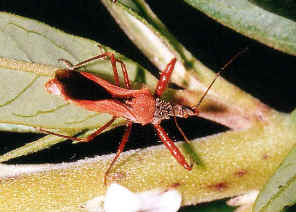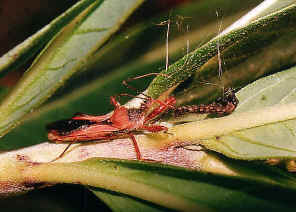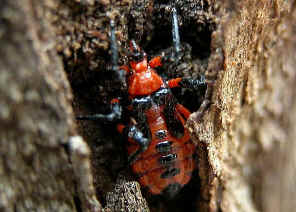Assassin Bugs - Family Reduviidae
All Assassin bugs are predators. They prey on all small animal such as snails, insects including caterpillars, spiders and other arthropods.

- Common Assassin Bug and its strong piercing-sucking mouthparts
They can be distinguished from other bugs by their elongated head and short curved proboscis. All other plant-feeding bugs have their proboscis flat against under their head when not in use. Assassin Bugs' proboscis is curved outwards from the head. To catch prey, Assassin Bugs swing their proboscis forwards to attack.
Assassin Bugs feed on their prey by puncturing them with sharp stylets in their proboscis, then inject saliva which will paralyses the prey, and then suck up the body fluids. As some other bugs, Assassin Bugs are slow moving. However, their bit can be painful.
The antennae of Assassin Bugs are four segmented and about the same length as the body. The legs are very long as well so that they have the longer attack distance.
Subfamily Harpactorinae
- Common Assassin Bug, Bee Killer


- Pristhesancus plagipennis, nymph body length 15mm, adult 20mm
- We found the Nymph Common Assassin Bug when it was chasing a small Flower Spider on the Hibiscus plants in our backyard in a mid autumn night. We only saw them once in our backyard. As most Assassin Bugs, it is bright orange in colour with black legs and long antenna. The adult Common Assassin Bug was found on a oak tree in Wishart in mid-winter. They have their distinct neck between thorax and head. They are predators of other small insects and spiders. Most Assassin Bugs will give a very painful bite, so don't touch them. More information on the Common Assassin Bugs page.
- Wallengren's Assassin Bug, Red Assassin Bug


- Gminatus wallengreni, body Length 17mm
- This assassin bugs look similar to the Common Assassin Bugs but the colour is different. The body are orange red in colour with black legs and black wings. We took the first picture in Wishart Bushland in early winter. Later in early summer we found a pair of the Red Assassin Bugs wandering near a Stingless Bee nest. They seem looking for chances to hunt some bees. More pictures and information please visit this page.
- Orange Assassin Bug


- Gminatus australia, body length 15mm
- Although this Red Assassin Bug is small in size, its fore legs is very strong and spiny. The bug is orange-red in colour with black wings. Its legs are orange-red too. The picture shows the bug feeding a ladybird larvae on a Milkweed plant. We found this bug when we were studying the ladybird larvae as predator on aphids. Somehow the ladybird larvae became the prey. We took those pictures in early spring.
- Ants Killer Assassin Bug

- ? Gminatus sp., body length 15mm
- We saw this Assassin Bug once in Karawatha Forest. It landed on a gum tree trunk with line of small black ants. It quickly punched on two ants with its sharp proboscis and flied away. The bug has the golden yellow colour body and all legs are in black.
- Ground Assassin Bug


- Ectomocoris decoratus, female body length 20mm, male nymph body length 16mm
- We found this orange and black Assassin Bug running very fast on forest floor. This bug will bite if handle by bare hand. The insect has very strong front pair legs. All its legs are orange in colour. Its orange colour body with black pattern is the standard assassin bug warning colour. This bug can sometimes be found under loose bark or on ground among plants materials. More pictures and information please visit this page.
- Termite Assassin Bug


- Tegea atropicta, adult body length 15mm, last instars body length 12mm
- In Australia this is the only one member in this subfamily. This Assassin Bug was found in later summer on a gum tree trunk in Wishart Bushland. This bug is known a specialist predator of termites which are found on trees or fallen logs. More information and pictures can be found in this page.
- Reference:
- 1. Insects of Australia, CSIRO, Division of Entomology, Melbourne University Press, 2nd Edition 1991, pp 494.
- 1. Insects of Australia, CSIRO, Division of Entomology, Melbourne University Press, 2nd Edition 1991, pp 494.
